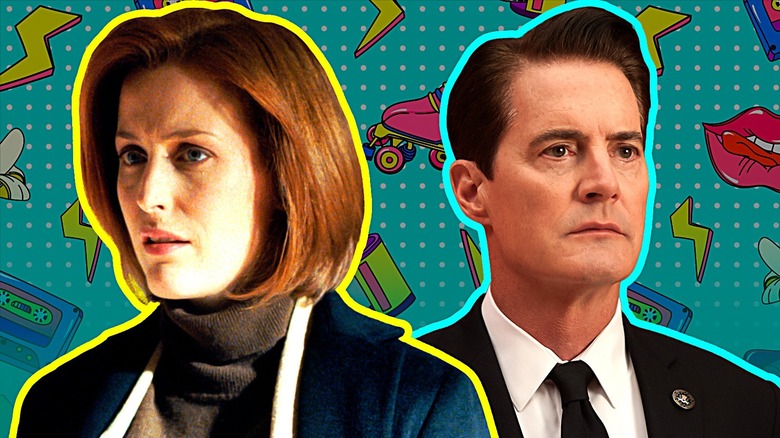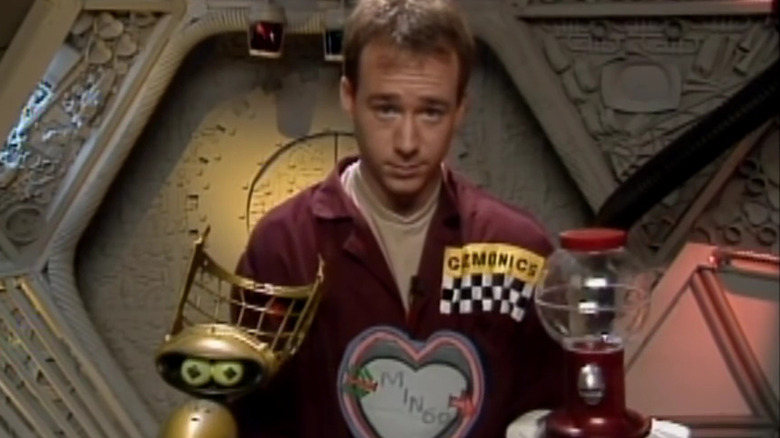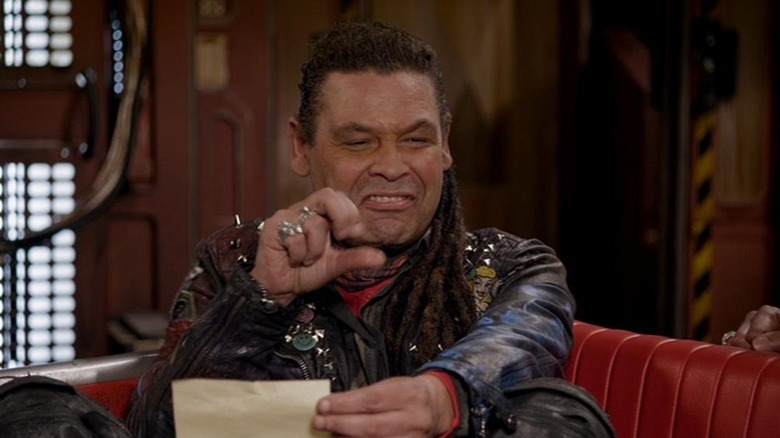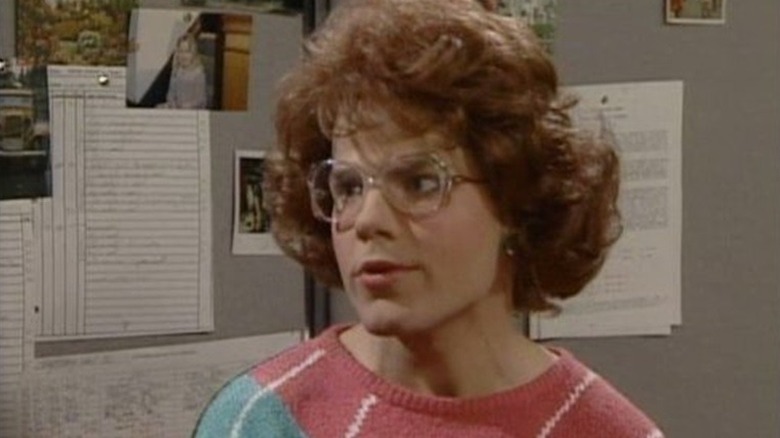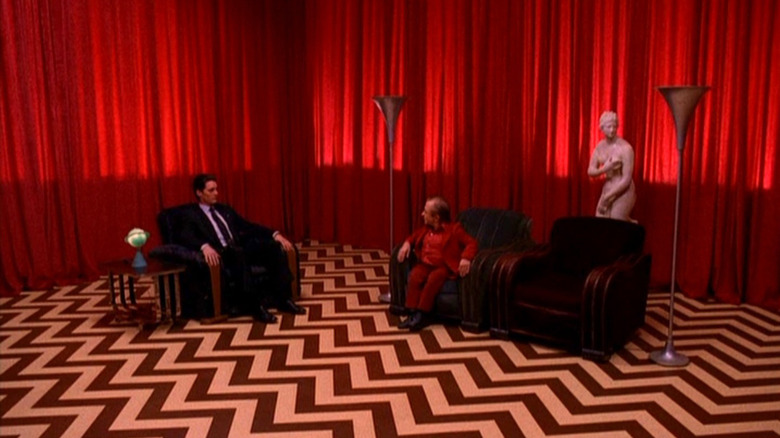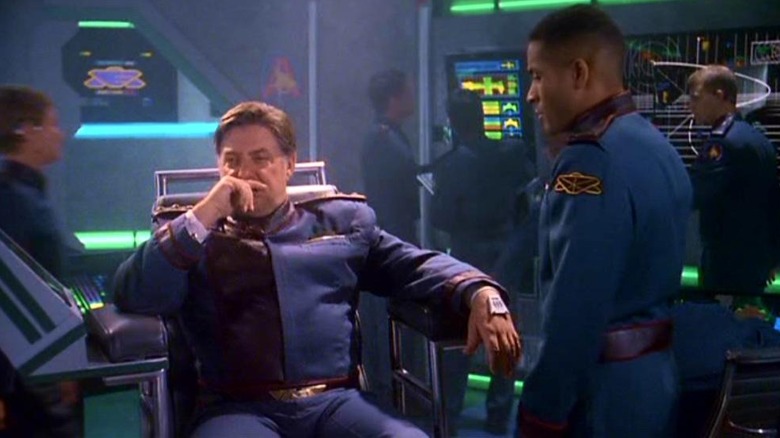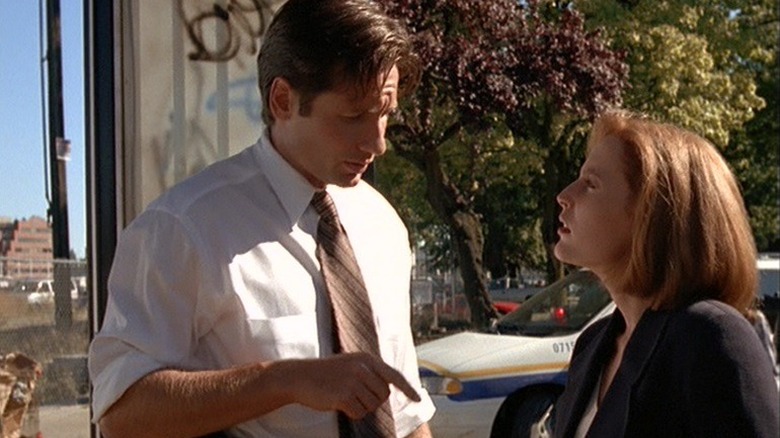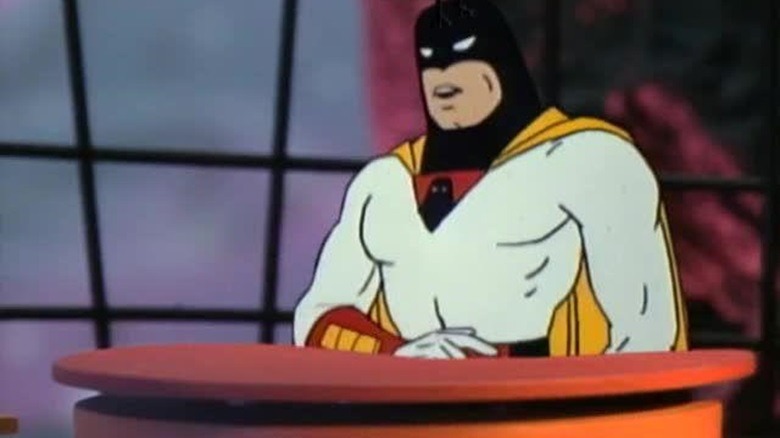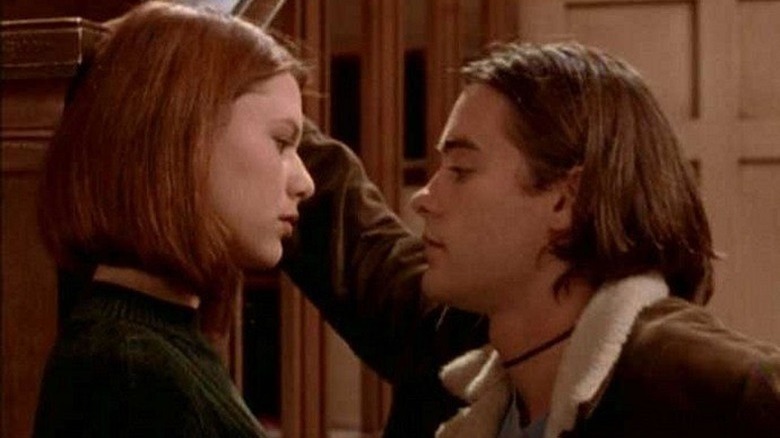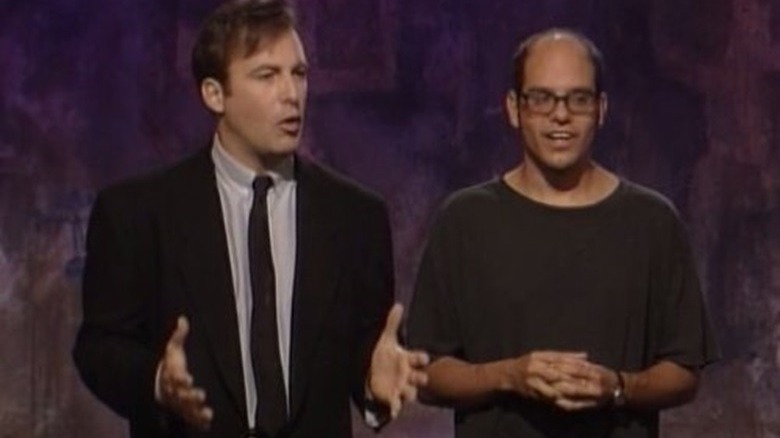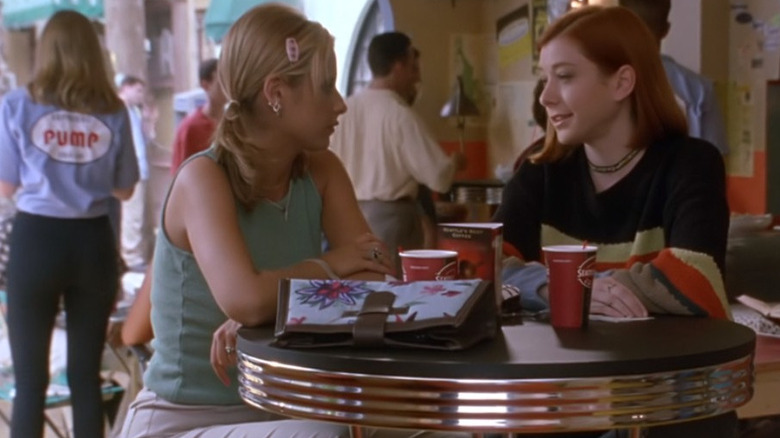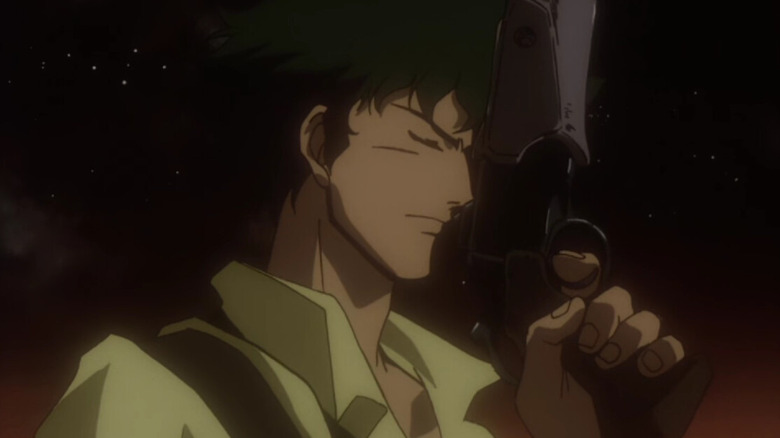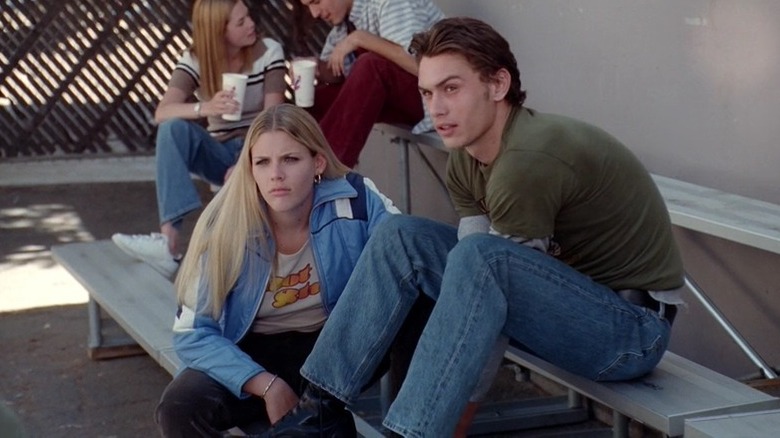'90s TV Shows That Became Cult Classics
Nowadays you could argue that "cult TV" is the default state of TV. With audiences fractioned between hundreds of channels and dozens of streaming services, consensus water-cooler hits are rare, and small but passionate fanbases desperate for their favorite shows to last beyond just one or two seasons are now the norm. Looking back, the '90s were a middle point between television's monocultural three-network past and its divided multi-channel present, with the rising forces of cable and home video shaping the medium's landscape in a way that helped shows — that might not have been the most obvious mainstream hits — find and develop cult followings.
Some of the '90s cult classics on this list sustained long runs with limited viewers, while others were arguably canceled too soon. A few of them successfully crossed over into mainstream popularity at least for a time, but still warrant inclusion here due to the passion of fans who stuck with them even when they were less popular. This list is organized in chronological order of when each series premiered (a few entries technically started in the '80s but fit this list due to airing the bulk of their episodes and having their biggest influence in the '90s). Give these shows a watch and you might just find yourself with a new (or renewed) obsession.
Mystery Science Theater 3000
"Mystery Science Theater 3000" first premiered in 1988 on the Minneapolis local station KTMA-TV, and in the decades since it's made its way around a lot of different networks and streaming services. If you were watching Comedy Central in the years before "South Park" and "The Daily Show" became its defining hits, or The Sci-Fi Channel at the end of the '90s, there's a good chance you saw some of the worst B-movies ever made — but with a human host (Joel Hodgson in Seasons 1 through 5, Mike Nelson from the second half of Season 5 through Season 10) and two robot puppets (Tom Servo and Crow T. Robot) making the pain bearable with their humorous commentary.
Made on the cheap by passionate outsiders, "MST3K" was a show built for a cult following. To spread awareness of the show in an era when Comedy Central had limited distribution, fans were encouraged to "keep circulating the tapes." Many years after the series' initial cancelation, fans were able to crowdfund two revivals of "MST3K," with two seasons hosted by Jonah Ray on Netflix and one hosted by Emily Marsh on the series' own Gizmoplex website. Many writers from Nelson's era went on to form Rifftrax, which does similar comedic commentary tracks for bad movies.
Red Dwarf
The biggest cult phenomenons on TV in the '90s were either science fiction or comedy series, so a combination of sci-fi and comedy seems particularly ready-made for cult classic status. "Red Dwarf," which ran for eight seasons from 1988 to 1999 before being revived for four seasons and a special between 2007 and 2020, was the defining British sci-fi show of the '90s — in part because it was basically the only British sci-fi show going strong in that decade.
BBC executives at the time weren't interested in the genre — "Doctor Who" got canceled in part because of this — so "Red Dwarf" took years to get off the ground, but its strong sense of humor kept it going strong. Despite critical acclaim and a passionate fanbase, the show's cast and crew always felt like outsiders at the network — lead actors Craig Charles and Danny John-Jules weren't even invited to celebrate the show's 1994 Emmy win because they were deemed "fire risks." Following the far-future misadventures of the universe's last human awakening from cryogenic deep sleep, "Red Dwarf" has frequently been compared with the American animated series "Futurama."
The Kids in the Hall
Launching with an hour-long pilot in 1988, the Canadian sketch comedy "The Kids in the Hall" ran for five seasons on CBC Broadcasting between 1989 and 1995. In the United States, the first three seasons aired on HBO, gaining enough attention that the last two seasons went to network television (albeit late at night) on CBS. Lorne Michaels of "Saturday Night Live" produced the show, but its five stars — Dave Foley, Kevin McDonald, Mark McKinney, Bruce McCulloch, and Scott Thompson — had a much stranger style of comedy, closer to the cult-favorite absurdity of the British classic, "Monty Python's Flying Circus."
"The Kids in the Hall" was both controversial and groundbreaking in the early '90s for its unabashed queer sensibility — Thompson was openly gay, and the rest of the group was quite comfortable with dressing up as women and homoerotic humor. The troupe's follow-up projects, including the 1996 film "Brain Candy" and the 2010 miniseries "Death Comes to Town," earned mixed reviews, but "The Kids in the Hall" eventually got a well-received sixth season on Amazon Prime Video in 2022.
Twin Peaks
How did a show as strange as "Twin Peaks" make it onto television in 1990, let alone become a hit? "Eraserhead" director David Lynch was certainly an offbeat choice for a network program, but his collaboration with "Hill Street Blues" writer Mark Frost produced an enticing mix of small-town drama, quirky comedy, and surreal supernatural darkness. In its first season, "Twin Peaks" was the show everyone was talking about, with viewers trying to solve the mystery of who killed Laura Palmer (Sheryl Lee) alongside FBI Agent Dale Cooper (Kyle MacLachlan).
Alas, the executives at ABC demanded the mystery be solved early in Season 2, and the show lost direction shortly after. Lynch and Frost became less and less involved as the ratings declined until returning for the season finale — which was the series finale at the time. A prequel film, 1992's "Twin Peaks: Fire Walk with Me," abandoned the series' campier comedic qualities in favor of sheer horror and was savaged by critics at the time but has undergone a positive reappraisal in the years since. A third season, titled "Twin Peaks: The Return," aired on Showtime in 2017, going in even more avant-garde directions and solidifying the series' legacy as both a brilliant and baffling cult classic.
Babylon 5
Created by J. Michael Straczynski, the sci-fi series "Babylon 5" ran for five seasons from 1993 to 1998, with the first four seasons airing on the now-defunct PTEN and the final one on TNT. At the time, the series was unusual for its complex pre-planned five-year narrative structure, described as "a novel for television" by Straczynski. Alongside "The X-Files," it was hugely influential in shifting genre television in a more serialized direction. The fact that it actually got to complete its full five-season plan and pulled it off successfully now feels like something of a miracle in these cancelation-happy times.
Set on a neutral space station where human and alien diplomats negotiate in the aftermath of an interplanetary war, "Babylon 5" drew inspiration from real-world history and mythology to address big political and philosophical ideas. Ahead of its time for a number of reasons, the series was among the first to directly market to and engage with its fanbase using the internet. Though it looks dated today, it was also groundbreaking at the time as one of the first TV shows to make heavy use of computer-generated special effects.
The X-Files
When Chris Carter's sci-fi conspiracy drama "The X-Files" began on Fox in 1993, it was quintessential cult TV: not a major ratings sensation, but those who watched it were hooked. Over the course of its first five seasons, more and more people became obsessed until it became a cultural phenomenon. At its best, the show balanced compelling "monster of the week" episodes with complex overarching mythology, while skeptic Dana Scully (Gillian Anderson) and believer Fox Mulder (David Duchovny) were the sort of characters you'd want to write fan-fiction about.
This success wouldn't last, with ratings declining over the final four seasons as fans debated whether the show was losing its touch after its 1998 movie. Ending in 2002, "The X-Files" got another movie in 2008 and was once again revived for two additional — and much-hated — seasons in 2016 and 2018. However, the show is still very much a product of the '90s. A full-on reboot is in the works, but it's questionable if one can make "The X-Files" work in a cultural environment where popular conspiracy theories trend less fun and more dangerous.
Space Ghost Coast to Coast
What do you do if you need to make a new animated show and have access to the entire Hanna-Barbera library but no money for fresh animation? If you're Cartoon Network vice president Mike Lazzo in 1994, you redub and repurpose footage from the forgotten '60s superhero cartoon "Space Ghost and Dino-Boy," mix in interviews with any minor celebrity willing to play along with the joke, and turn it into the dadaist late-night talk show "Space Ghost Coast to Coast."
The low cost of making the show allowed it to get extremely off the wall throughout its 11 seasons (one memorable episode had Space Ghost cut off an interview with Conan O'Brien early to spend 11 minutes chasing a fire ant). Though the content was not necessarily inappropriate for kids in the early seasons, "Space Ghost Coast to Coast" appealed to an older crowd than most of Cartoon Network's programming. It ended up forming the basis of the Adult Swim block, which would be its new home starting in 2001 until its final episodes in 2004.
My So-Called Life
Had "My So-Called Life" come out a few years later, it probably could have had a comfortable run amongst the teen-centric line-ups of UPN or The WB. Alas, Winnie Holzman's high school drama was a bit too ahead of its time on ABC in 1994, and it didn't get high enough ratings to get renewed for a second season. This was despite pretty much everyone who watched the show loving it, including teenagers, parents, critics, network executives, and even Steven Spielberg.
Launching the acting careers of Claire Danes and Jared Leto, "My So-Called Life" avoided the cheesy soap opera style and "after-school special" preachiness of the era's other teen shows in favor of realistic angst and dealing seriously with social issues via ongoing storylines. The parents got as much character development as the kids. This was a choice made out of necessity due to the child actors' limited shooting hours but one that helped it connect with older viewers as well as younger ones. It might have been canceled too soon, but this cult favorite has gone on to be viewed as perhaps the most influential teen show ever.
Mr. Show with Bob and David
Before David Cross starred in the defining 2000s cult classic "Arrested Development" and before Bob Odenkirk went dramatic as Saul Goodman in the "Breaking Bad" universe, there was "Mr. Show with Bob and David," a surreal sketch comedy that ran for four seasons on HBO from 1995 to 1998. Cross and Odenkirk starred alongside John Ennis, Tom Kenny (the voice of SpongeBob SquarePants), Jill Talley, and, more unfortunately, future January 6th rioter, Jay Johnston.
The list of other comedians who featured on or wrote for the show, including Jack Black, Scott Aukerman, Brian Posehn, Sarah Silverman, and Paul F. Tompkins, make it a veritable who's who of some of the coolest comedic talent — many of whom would go on to more great things over the next few decades. Even if you've never seen "Mr. Show," you've almost certainly watched and probably enjoyed at least one of the many series that cites it as an inspiration — including the Emmy-winning "Abbott Elementary." A four-episode pseudo-revival titled "W/ Bob & David" received four episodes and a behind-the-scenes special on Netflix in 2015.
Buffy the Vampire Slayer
Joss Whedon has described "Buffy the Vampire Slayer," the TV remake/expansion of his failed 1992 movie of the same title, as a cross between "My So-Called Life" and "The X-Files." It's no wonder that combining the strengths of two other cult classics on this list would result in one of the biggest cult classics of them all. Premiering on The WB in 1997 before switching networks to UPN in 2001, the series ran for seven seasons until 2003, launching the spinoff series "Angel" along the way. It also had a healthy afterlife via comics continuing the story.
Buffy Summers' (Sarah Michelle Gellar) coming-of-age while saving the world story struck a chord with a generation of geeks and inspired many supernatural-themed shows to come afterward. Academics dug deep into it, making "Buffy Studies" a thing, and the show was praised as a great work of pop feminism in its time — though later stories of Whedon's mistreatment of female cast members would force a more critical reassessment of the show's gender politics. Whedon would spend the 2000s creating quickly-canceled cult favorites such as "Firefly" and "Dollhouse" before breaking through to the mainstream in the 2010s with one of the biggest superhero movies of the time, "The Avengers."
Cowboy Bebop
Anime, in general, has long been treated as a cult thing in the United States, and even in Japan, as a lot of anime aims for extremely niche markets. When talking about '90s anime cult classics, "Cowboy Bebop" stands out in particular as a show that had pretty much everything against it when it first premiered in 1998 yet is still beloved over 25 years later. By defying the era's popular trends — no giant robots, and a jazz soundtrack instead of J-pop — Shinichiro Watanabe's genre-blending space bounty hunter show became something unique and timeless.
The initial run of "Cowboy Bebop" on TV Tokyo only aired 12 of the series' 26 episodes, with the rest deemed too violent for broadcast. The concluding episodes aired on the satellite network WOWOW. "Cowboy Bebop" started taking off as a cult favorite among American viewers as the first anime on Cartoon Network's Adult Swim block in 2001. The block's programmers kept rerunning it for years — not due to exceptional ratings but because they loved the show — and over time more and more fans shared that love. The show's Western influences made it a particularly effective gateway anime for newcomers. Even a disastrous live-action Netflix adaptation can't taint its legacy.
Freaks and Geeks
It's easy to imagine an alternate universe where "Freaks and Geeks" isn't seen as a cult classic but as a classic period, but alas, it never had a chance at mainstream success with the way NBC treated the show. The series' humor and drama was relatable to anyone who felt awkward in high school — but Garth Ancier, NBC's president at the time, did not relate (he went to a private boarding school before going to Princeton) and didn't know what to do with the show. Executives kept pushing for the characters to be cooler and have more victories, going completely against the point of the show's realistic approach. With terrible timeslots and entire episodes skipped, "Freaks and Geeks" didn't last beyond the 1999-2000 season.
And like a real-life "revenge of the nerds," pretty much everyone who worked on "Freaks and Geeks" went on to define popular comedy in the early 21st century. Series creator Paul Feig and executive producer Judd Apatow would go on to make blockbuster hit movies like "Bridesmaids" and "Knocked Up." John Francis Daley went from playing a "Dungeons & Dragons" geek on TV to writing and directing "Dungeons & Dragons: Honor Among Thieves" in a wonderful full-circle moment. Crucially, actors such as Seth Rogen, Linda Cardelini, Jason Segel, James Franco, Martin Starr, and Busy Phillips all got their start on "Freaks and Geeks."
